Time-Series Study of Associations between Rates of People Affected by Disasters and the El Niño Southern Oscillation (ENSO) Cycle
Abstract
1. Introduction
2. Materials and Methods
2.1. Disaster Databases
2.2. Niño Years and ENSO Indices
2.3. Statistical Analysis
3. Results
3.1. Descriptive Statistics
3.2. Global Analysis
3.3. Regional Analysis
3.4. Country Analysis
3.5. The Possible Modulation of ENSO-PAD Associations by the Pacific Decadal Oscillation
4. Discussion
5. Conclusions
Author Contributions
Funding
Conflicts of Interest
Appendix A
| Disaster Type and Country Affected | N (Years) | PAD | PAD Rate (per 1000) | |||||
|---|---|---|---|---|---|---|---|---|
| Mean | Standard Deviation | Total | Mean | Standard Deviation | Total | |||
| Southern Asia | ||||||||
| Flood | Bangladesh | 44 | 7,550,661.11 | 11,492,162.74 | 332,229,089.00 | 76.92 | 126.12 | 3384.41 |
| India | 48 | 18,079,598.83 | 21,096,396.54 | 867,820,744.00 | 19.97 | 23.49 | 958.42 | |
| Pakistan | 37 | 2,145,508.70 | 4,087,179.70 | 79,383,822.00 | 17.50 | 30.85 | 647.32 | |
| Sri Lanka | 38 | 424,075.66 | 363,428.43 | 16,114,875.00 | 23.72 | 21.17 | 901.54 | |
| Storm | Bangladesh | 48 | 1,766,055.88 | 3,622,470.20 | 84,770,682.00 | 18.90 | 47.32 | 907.30 |
| India | 45 | 2,211,721.60 | 3,811,566.05 | 99,527,472.00 | 2.63 | 4.62 | 118.25 | |
| Southeast Asia | ||||||||
| Flood | Indonesia | 44 | 241,857.48 | 219,953.42 | 10,641,729.00 | 1.29 | 1.19 | 56.79 |
| Philippines | 42 | 793,572.24 | 1,197,212.63 | 33,330,034.00 | 10.40 | 15.92 | 436.74 | |
| Thailand | 32 | 1,879,431.63 | 2,488,868.57 | 60,141,812.00 | 30.61 | 38.08 | 979.59 | |
| Viet Nam | 32 | 1,028,385.94 | 1,479,383.08 | 32,908,350.00 | 13.97 | 21.09 | 447.08 | |
| Storm | Philippines | 52 | 3,168,649.98 | 3,701,601.92 | 164,769,799.00 | 42.93 | 40.23 | 2232.25 |
| Viet Nam | 40 | 1,333,759.03 | 2,715,834.20 | 53,350,361.00 | 20.00 | 47.33 | 800.02 | |
| Eastern Asia | ||||||||
| Flood | China | 38 | 54,112,338.82 | 65,199,287.36 | 2,056,268,875.00 | 42.61 | 51.86 | 1619.18 |
| Storm | China | 36 | 13,709,379.22 | 20,594,509.62 | 493,537,652.00 | 10.66 | 15.90 | 383.71 |
| Hong Kong | 30 | 1932.43 | 3401.67 | 57,973.00 | 0.37 | 0.59 | 11.23 | |
| Japan | 41 | 58,561.39 | 84,776.22 | 2,401,017.00 | 0.47 | 0.69 | 19.43 | |
| Korea | 31 | 22,130.71 | 33,676.08 | 686,052.00 | 0.57 | 0.95 | 17.75 | |
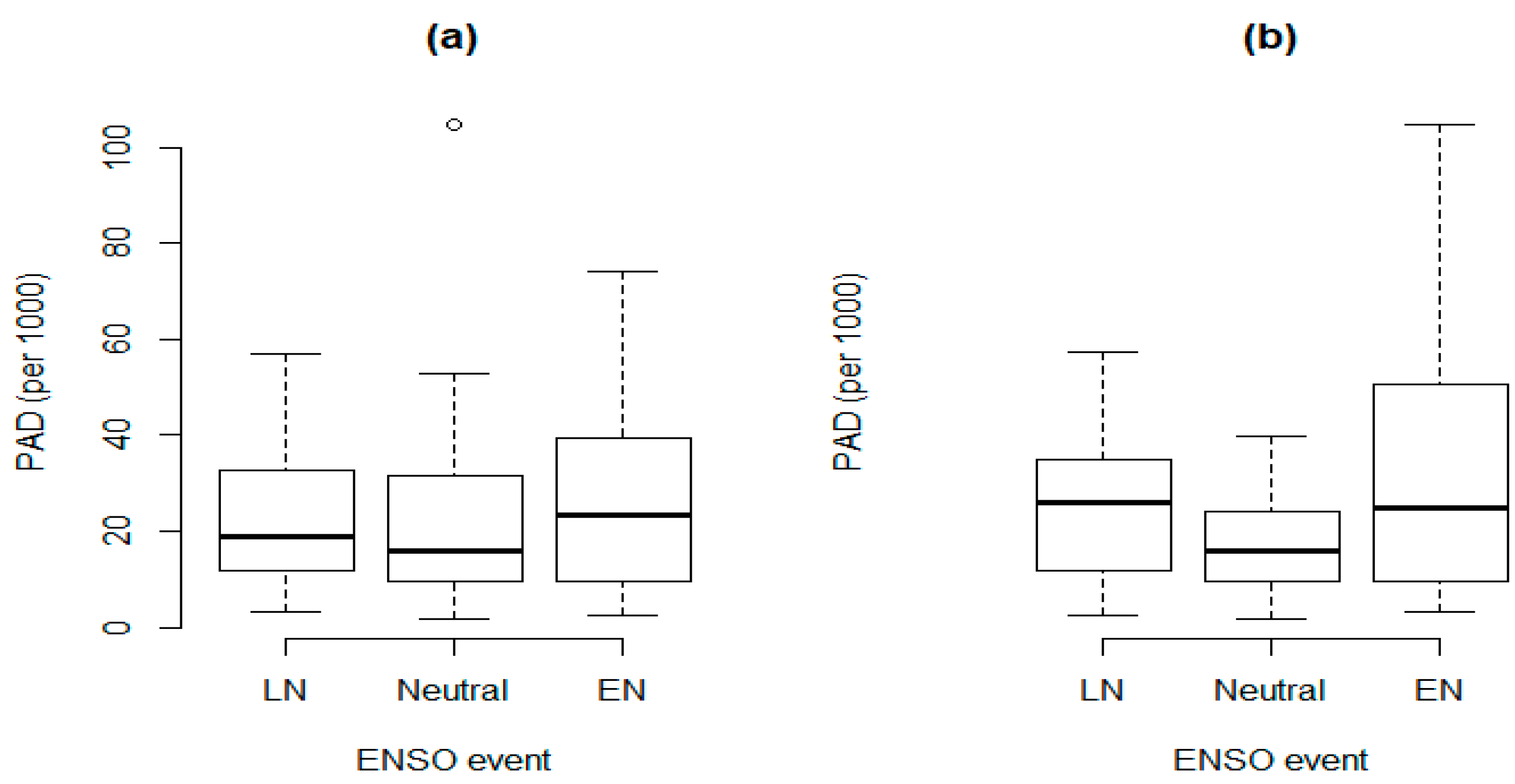
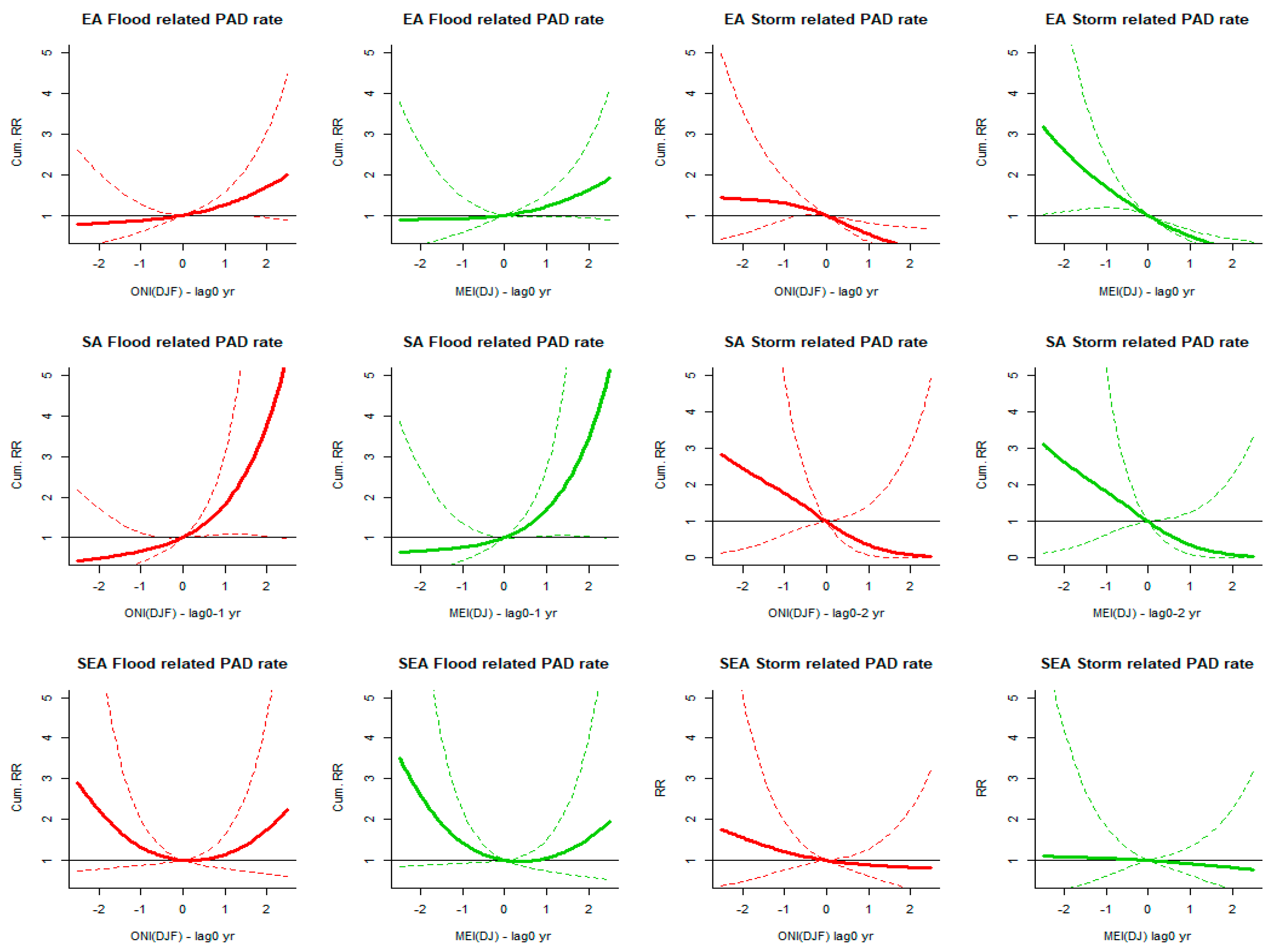
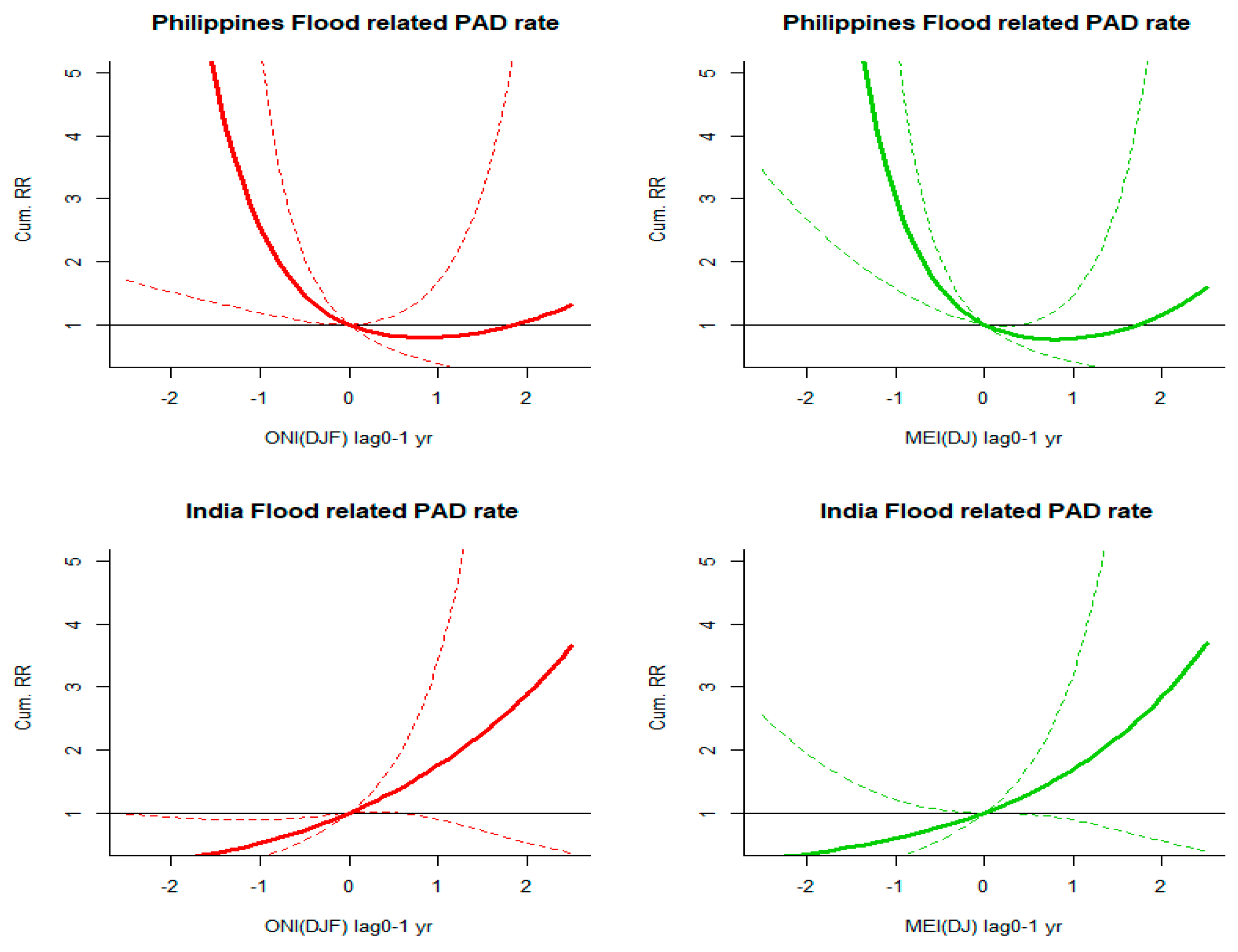
References
- NOAA Cold & Warm Episodes by Season. Available online: https://origin.cpc.ncep.noaa.gov/products/analysis_monitoring/ensostuff/ONI_v5.php (accessed on 28 August 2019).
- Chen, S.; Chen, W.; Wei, K. Recent trends in winter temperature extremes in eastern China and their relationship with the Arctic Oscillation and ENSO. Adv. Atmos. Sci. 2013, 30, 1712–1724. [Google Scholar] [CrossRef]
- Ronghui, H.; Wen, C.; Bangliang, Y.; Renhe, Z. Recent advances in studies of the interaction between the East Asian winter and summer monsoons and ENSO cycle. Adv. Atmos. Sci. 2004, 21, 407–424. [Google Scholar] [CrossRef]
- Song, L.; Chen, S.; Chen, W.; Chen, X. Distinct impacts of two types of La Niña events on Australian summer rainfall. Int. J. Climatol. 2017, 37, 2532–2544. [Google Scholar] [CrossRef]
- Kovats, R.S.; Bouma, M.J.; Hajat, S.; Worral, E.; Haines, A. El Niño and health. Lancet 2003, 362, 1481–1489. [Google Scholar] [CrossRef]
- McGregor, G.R.; Ebi, K. El Niño Southern Oscillation (ENSO) and Health An overview for climate and Health Researchers. Atmosphere 2018, 9, 282. [Google Scholar] [CrossRef]
- World Health Organization El Niño Affects More than 60 Million People. Available online: http://www.who.int/news-room/feature-stories/detail/el-niño-affects-more-than-60-million-people (accessed on 20 July 2018).
- Caminade, C.; Turner, J.; Metelmann, S.; Hesson, J.C.; Blagrove, M.S.C.; Solomon, T.; Morese, A.P.; Baylis, M. Global risk model for vector-borne transmission of Zika virus reveals the role of El Niño 2015. Proc. Natl. Acad. Sci. USA 2017, 114, 119–124. [Google Scholar] [CrossRef] [PubMed]
- Anyamba, A.; Chretien, J.-P.; Britch, S.C.; Soebiyanto, R.P.; Small, J.L.; Jepsen, R.; Forshey, B.M.; Sanchez, J.L.; Smith, R.D.; Harris, R.; et al. Global disease outbreaks associated with the 2015–2016 El Nino Event. Sci. Rep. 2019, 9, 1930. [Google Scholar] [CrossRef] [PubMed]
- Anyamba, A.; Chretien, J.; Small, J.; Tucker, C.J.; Linthicum, K.J. Developing global climate anomalies suggest potential disease risks for 2006–2007. Int. J. Health Geogr. 2006, 5, 60. [Google Scholar] [CrossRef]
- Fisman, D.N.; Tutie, A.R.; Brown, K.A. Impact of El Niño Southern Oscillation on infectious disease hospitalization risk in the United States. Proc. Natl. Acad. Sci. USA 2016, 113, 14589–14594. [Google Scholar] [CrossRef]
- Aalst, M.K. Van The impacts of climate change on the risk of natural disasters Maarten K. van Aalst Climate Specialist, Red Cross/Red Crescent Centre on Climate Change and Disaster Preparedness, Netherlands. Disasters 2006, 30, 5–18. [Google Scholar] [CrossRef]
- Diley, M.; Heyman, B. ENSO and disaster: Droughts, floods and El Niño/Southern Oscillation warm events. Disasters 1995, 19, 181–193. [Google Scholar] [CrossRef]
- Hijar, G.; Bonilla, C.; Munayco, C.V.; Gutierrez, E.L.; Ramos, W. El Niño phenomenon and natural disasters: Public health interventions for disaster preparedness and response. Rev. Peru. Med. Exp. Salud Publica 2016, 33, 305–315. [Google Scholar]
- Steptoe, H.; Jones, S.E.O.; Fox, H. Correlations Between Extreme Atmospheric Hazards and Global Teleconnections: Implications for Multihazard Resilience. Rev. Geophys. 2018, 56, 50–78. [Google Scholar] [CrossRef]
- Chan, E.Y.Y.; Ho, J.Y.; Hung, H.H.Y.; Liu, S.; Lam, H.C.Y. Health impact of climate change in cities of middle-income countries: The case of China. Br. Med. Bull. 2019, 130, 5–24. [Google Scholar] [CrossRef] [PubMed]
- Chan, E.; Huang, Z.; Lam, H.; Wong, C.; Zou, Q.; Chan, E.Y.Y.; Huang, Z.; Lam, H.C.Y.; Wong, C.K.P.; Zou, Q. Health Vulnerability Index for Disaster Risk Reduction: Application in Belt and Road Initiative (BRI) Region. Int. J. Environ. Res. Public Health 2019, 16, 380. [Google Scholar] [CrossRef]
- Ward, P.J.; Jongman, B.; Kummu, M.; Dettinger, M.D.; Sperna Weiland, F.C.; Winsemius, H.C. Strong influence of El Niño Southern Oscillation on flood risk around the world. Proc. Natl. Acad. Sci. USA 2014, 111, 15659–15664. [Google Scholar] [CrossRef] [PubMed]
- Bouma, M.J.; Kovats, R.S.; Goubet, S.A.; Cox, J.S.H.; Haines, A. Global assessment of El Niño’s disaster burden. Lancet 1997, 350, 1435–1438. [Google Scholar] [CrossRef]
- Wallemacq, P.; Below, R.; McLean, D. CRED & UNISDR Report: Economic Losses, Poverty & Disasters 1998–2017. Available online: https://www.unisdr.org/files/61119_credeconomiclosses.pdf (accessed on 28 August 2019).
- Perry, S.J.; McGregor, S.; Gupta, A.S.; England, M.H. Future Changes to El Niño–Southern Oscillation Temperature and Precipitation Teleconnections. Geophys. Res. Lett. 2017, 44, 10608–10616. [Google Scholar] [CrossRef]
- CRED EM-DAT: The Emergency Events Database. Available online: www.emdat.be (accessed on 20 July 2018).
- Constitution of the World Health Organization. Available online: https://www.who.int/governance/eb/who_constitution_en.pdf (accessed on 28 August 2019).
- United Nations World Population Prospects 2017. Available online: https://population.un.org/wpp/DataQuery/ (accessed on 20 July 2018).
- NOAA El Nino Southern Oscillation (ENSO). Available online: https://www.esrl.noaa.gov/psd/enso/dashboard.lanina.html (accessed on 20 July 2018).
- NOAA Climate.gov March 2015 ENSO Discussion: El Niño is Here. Available online: https://www.climate.gov/news-features/blogs/enso/march-2015-enso-discussion-el-niño-here (accessed on 20 July 2018).
- Hong Kong Observatory El Niño and La Niña-Background Information. Available online: http://www.hko.gov.hk/lrf/enso/enso-backgnd.htm (accessed on 20 July 2018).
- Met Office El Niño Southern Oscillation (ENSO) Region Sea Surface Temperature Forecasts. Available online: https://www.metoffice.gov.uk/research/climate/seasonal-to-decadal/gpc-outlooks/el-nino-la-nina (accessed on 20 July 2018).
- Null, J. El Niño and La Niña Years and Intensities. Available online: https://ggweather.com/enso/oni.htm (accessed on 26 November 2018).
- Timmermann, A.; An, S.; Kug, J.; Jin, F.; Cai, W.; Capotondi, A.; Cobb, K.; Lengaigne, M.; Mcphaden, M.J.; Stuecker, M.F.; et al. El Niño—Southern Oscillation complexity. Nature 2018, 559, 535–545. [Google Scholar] [CrossRef]
- Gasparrini, A. Distributed lag linear and non-linear models: The R the package dlnm. J. Stat. Softw. 2017, 43, 1–20. [Google Scholar]
- Simon, N.W. Generalized Additive Models: An Introduction with R; Chapman & Hall: London, UK, 2006. [Google Scholar]
- R Core Team R. A Language and Environment for Statistical Computing; R Foundation for Statistical Computing: Vienna, Austria, 2014. [Google Scholar]
- IBM Corp. IBM SPSS Statistics Version 22. IBM SPSS Statistics for Windows; IBM Corp: New York, NY, USA, 2013. [Google Scholar]
- Girishkumar, M.S.; Thanga Prakash, V.P.; Ravichandran, M. Influence of Pacific Decadal Oscillation on the relationship between ENSO and tropical cyclone activity in the Bay of Bengal during October–December. Clim. Dyn. 2015, 44, 3469–3479. [Google Scholar] [CrossRef]
- Krishnamurthy, L.; Krishnamurthy, V. Influence of PDO on South Asian summer monsoon and monsoon–ENSO relation. Clim. Dyn. 2014, 42, 2397–2410. [Google Scholar] [CrossRef]
- Wang, X.; Liu, H. PDO modulation of ENSO effect on tropical cyclone rapid intensification in the western North Pacific. Clim. Dyn. 2016, 46, 15–28. [Google Scholar] [CrossRef]
- Chen, W.; Feng, J.; Wu, R.; Chen, W.; Feng, J.; Wu, R. Roles of ENSO and PDO in the Link of the East Asian Winter Monsoon to the following Summer Monsoon. J. Clim. 2013, 26, 622–635. [Google Scholar] [CrossRef]
- Trenberth, K.E.; Dai, A.; van der Schrier, G.; Jones, P.D.; Barichivich, J.; Briffa, K.R.; Sheffield, J. Global warming and changes in drought. Nat. Clim. Chang. 2014, 4, 17–22. [Google Scholar] [CrossRef]
- Wang, S.; Huang, J.; He, Y.; Guan, Y. Combined effects of the Pacific Decadal Oscillation and El Niño-Southern Oscillation on Global Land Dry–Wet Changes. Sci. Rep. 2015, 4, 6651. [Google Scholar] [CrossRef] [PubMed]
- Ashok, K.; Guan, Z.; Saji, N.; Yamagata, T. Individual and Combined Influences of ENSO and the Indian Ocean Dipole on the Indian Summer Monsoon. J. Clim. 2004, 17, 3141–3155. [Google Scholar] [CrossRef]
- NOAA Climate.gov Global Impacts of El Niño and La Niña. Available online: https://www.climate.gov/news-features/featured-images/global-impacts-el-niño-and-la-niña (accessed on 20 July 2018).
- Morán-Tejeda, E.; Bazo, J.; López-Moreno, J.I.; Aguilar, E.; Azorín-Molina, C.; Sanchez-Lorenzo, A.; Martínez, R.; Nieto, J.J.; Mejía, R.; Martín-Hernández, N.; et al. Climate trends and variability in Ecuador (1966–2011). Int. J. Climatol. 2016, 36, 3839–3855. [Google Scholar] [CrossRef]
- Sanabria, J.; Bourrel, L.; Dewitte, B.; Frappart, F.; Rau, P.; Solis, O.; Labat, D. Rainfall along the coast of Peru during strong El Niño events. Int. J. Climatol. 2018, 38, 1737–1747. [Google Scholar] [CrossRef]
- Villar, J.C.E.; Ronchail, J.; Guyot, J.L.; Cochonneau, G.; Naziano, F.; Lavado, W.; de Oliveira, E.; Pombosa, R.; Vauchel, P. Spatio-temporal rainfall variability in the Amazon basin countries (Brazil, Peru, Bolivia, Colombia, and Ecuador). Int. J. Climatol. 2009, 29, 1574–1594. [Google Scholar] [CrossRef]
- L’Heureux, M.L.; Tippett, M.K.; Kumar, A.; Butler, A.H.; Ciasto, L.M.; Ding, Q.; Harnos, K.J.; Johnson, N.C. Strong Relations Between ENSO and the Arctic Oscillation in the North American Multimodel Ensemble. Geophys. Res. Lett. 2017, 44, 11654–11662. [Google Scholar] [CrossRef]
- Lowe, R.; Stewart-Ibarra, A.M.; Petrova, D.; García-Díez, M.; Borbor-Cordova, M.J.; Mejía, R.; Regato, M.; Rodó, X. Climate services for health: Predicting the evolution of the 2016 dengue season in Machala, Ecuador. Lancet Planet. Heal. 2017, 1, e142–e151. [Google Scholar] [CrossRef]
- Hu, P.; Zhang, Q.; Shi, P.; Chen, B.; Fang, J. Flood-induced mortality across the globe: Spatiotemporal pattern and influencing factors. Sci. Total Environ. 2018, 643, 171–182. [Google Scholar] [CrossRef] [PubMed]
- Cai, W.; Santoso, A.; Wang, G.; Yeh, S.; An, S.; Cobb, K.M.; Collins, M.; Guilyardi, E.; Jin, F.; Kug, J.; et al. ENSO and greenhouse warming. Nat. Publ. Gr. 2015, 5, 849–859. [Google Scholar] [CrossRef]
- Fernandez, A.; Black, J.; Jones, M.; Wilson, L.; Salvador-Carulla, L.; Astell-Burt, T.; Black, D. Flooding and mental health: A systematic mapping review. PLoS ONE 2015, 10. [Google Scholar] [CrossRef]
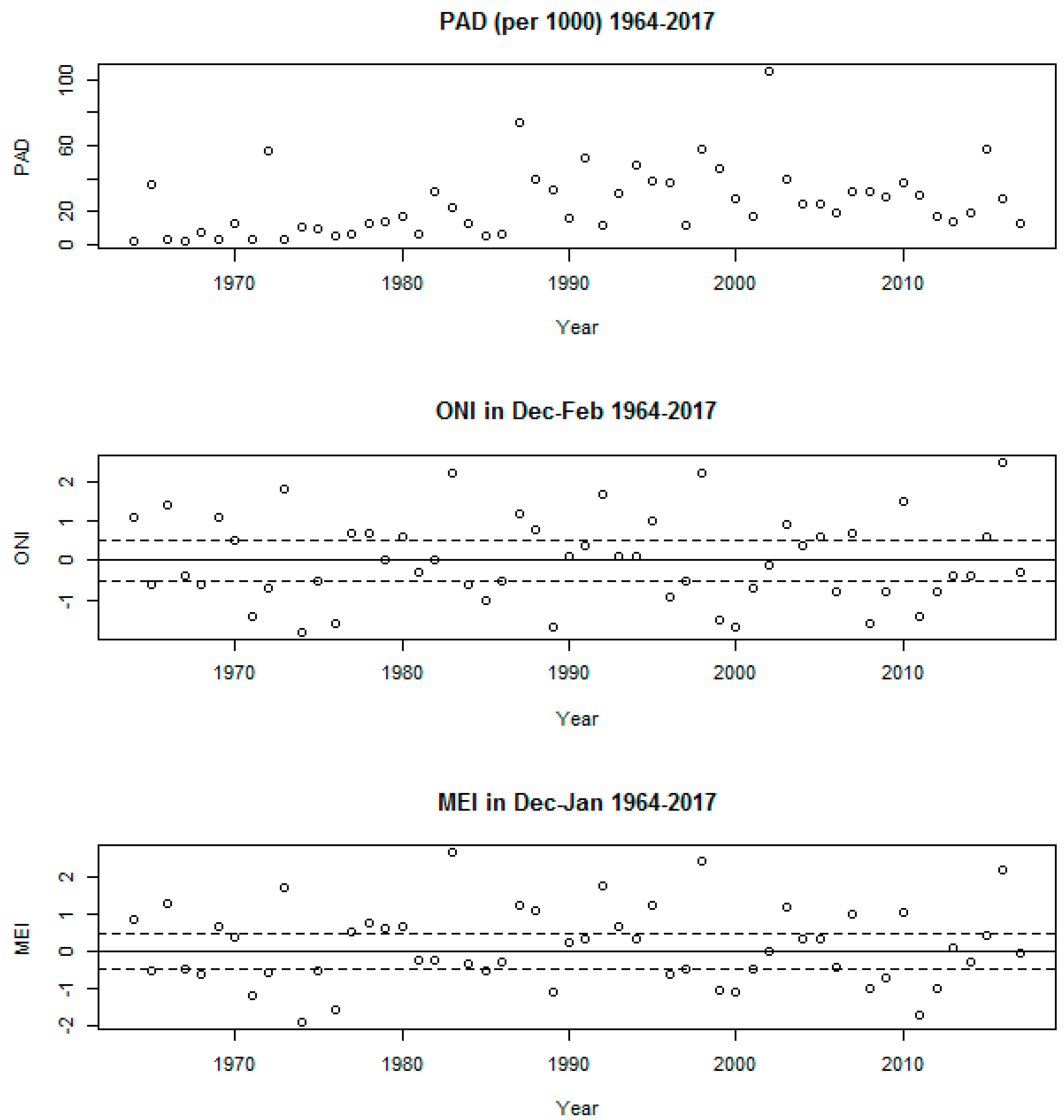
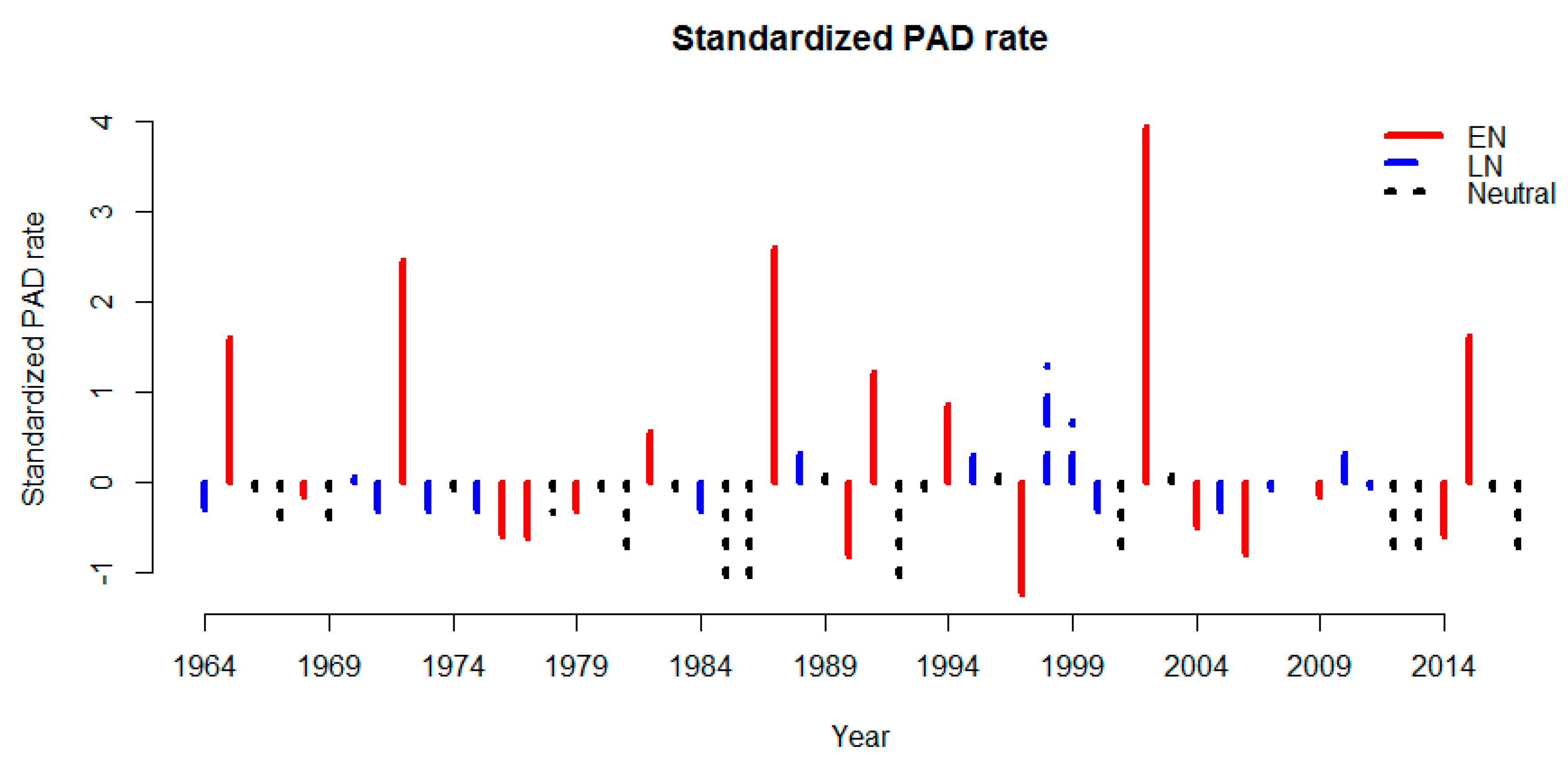
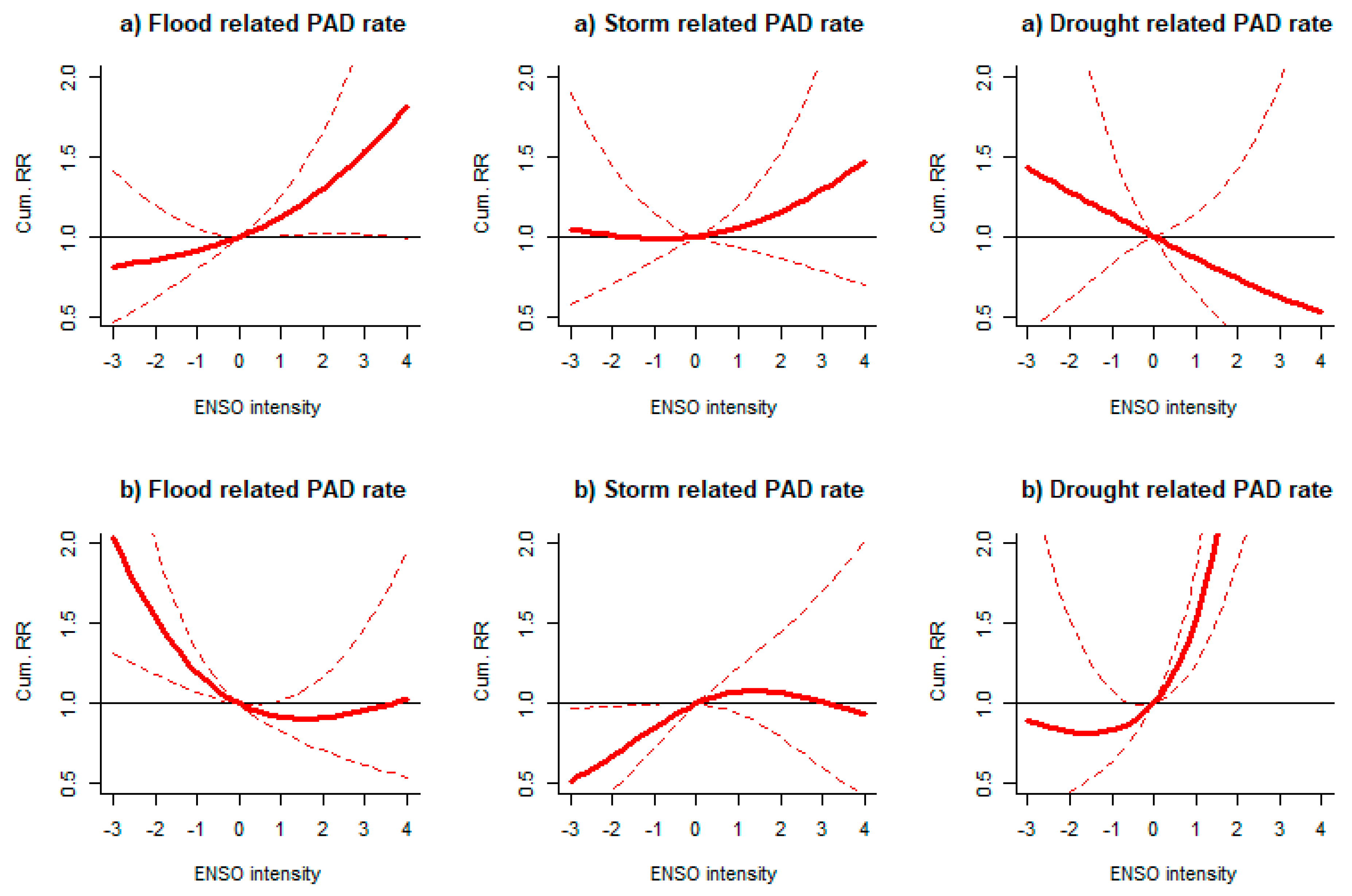
| Region | All Natural Disasters | Droughts | Floods | Storms |
|---|---|---|---|---|
| World | ||||
| Number of years with recorded event (N) | 54 | 54 | 54 | 54 |
| Median of yearly PAD rate (per 1000) | 19.20 | 2.97 | 8.38 | 2.59 |
| Median of yearly total PAD | 123,262,882 | 16,932,171 | 43,923,263 | 14,924,902 |
| Total PAD in all years | 7,848,332,058 | 2,656,928,512 | 3,730,385,245 | 1,111,097,557 |
| % of all global PAD burden | 33.85% | 47.53% | 14.16% | |
| Eastern Asia | ||||
| Number of years with recorded event (N) | 23 | 49 | 52 | |
| Median of yearly PAD rate (per 1000) | 10.74 | 5.20 | 1.42 | |
| Median of yearly total PAD | 16,330,000 | 7,718,344 | 2,230,618 | |
| Total PAD in all years | 534,250,000 | 2,065,818,428 | 502,885,480 | |
| Regional contribution to global PAD burden | 20.11% | 55.38% | 45.26% | |
| Southern Asia | ||||
| Number of years with recorded event (N) | 24 | 53 | 54 | |
| Median of yearly PAD rate (per 1000) | 1.65 | 11.73 | 1.25 | |
| Median of yearly total PAD | 1,950,000 | 16,681,018 | 1,270,373 | |
| Total PAD in all years | 1,478,885,000 | 1,306,601,275 | 189,308,058 | |
| Regional contribution to global PAD burden | 55.66% | 35.03% | 17.04% | |
| South-eastern Asia | ||||
| Number of years with recorded event (N) | 26 | 52 | 53 | |
| Median of yearly PAD rate (per 1000) | 3.79 | 3.39 | 6.34 | |
| Median of yearly total PAD | 2,065,844 | 1,467,589 | 2,704,570 | |
| Total PAD in all years | 77,006,716 | 161,721,850 | 228,053,018 | |
| Regional contribution to global PAD burden | 2.90% | 4.34% | 20.53% |
| Intensities of ONI and MEI | ONI (DJF) | MEI (DJ) |
|---|---|---|
| ONI & MEI intensity in the same year as the disaster year (N = 50) | RR in same year (95% CI) (compared to ONI = 0) | RR in same year (95% CI) (compared to MEI = 0) |
| −2 (lower boundary for very strong) | 1.14 (0.52, 2.51) | 1.30 (0.54, 3.12) |
| −1.5 (lower boundary for strong) | 1.09 (0.63, 1.88) | 1.19 (0.65, 2.19) |
| −1 (lower boundary for moderate) | 1.04 (0.76, 1.43) | 1.10 (0.78, 1.59) |
| −0.5 (lower boundary for weak) | 1.01 (0.88, 1.15) | 1.04 (0.89, 1.21) |
| 0.5 (lower boundary for weak) | 1.02 (0.93, 1.13) | 0.99 (0.89, 1.10) |
| 1 (lower boundary for moderate) | 1.07 (0.86, 1.33) | 1.00 (0.81, 1.25) |
| 1.5 (lower boundary for strong) | 1.13 (0.79, 1.63) | 1.04 (0.73, 1.49) |
| 2 (lower boundary for very strong) | 1.22 (0.71, 2.11) | 1.10 (0.64, 1.88) |
© 2019 by the authors. Licensee MDPI, Basel, Switzerland. This article is an open access article distributed under the terms and conditions of the Creative Commons Attribution (CC BY) license (http://creativecommons.org/licenses/by/4.0/).
Share and Cite
Lam, H.C.Y.; Haines, A.; McGregor, G.; Chan, E.Y.Y.; Hajat, S. Time-Series Study of Associations between Rates of People Affected by Disasters and the El Niño Southern Oscillation (ENSO) Cycle. Int. J. Environ. Res. Public Health 2019, 16, 3146. https://doi.org/10.3390/ijerph16173146
Lam HCY, Haines A, McGregor G, Chan EYY, Hajat S. Time-Series Study of Associations between Rates of People Affected by Disasters and the El Niño Southern Oscillation (ENSO) Cycle. International Journal of Environmental Research and Public Health. 2019; 16(17):3146. https://doi.org/10.3390/ijerph16173146
Chicago/Turabian StyleLam, Holly Ching Yu, Andy Haines, Glenn McGregor, Emily Ying Yang Chan, and Shakoor Hajat. 2019. "Time-Series Study of Associations between Rates of People Affected by Disasters and the El Niño Southern Oscillation (ENSO) Cycle" International Journal of Environmental Research and Public Health 16, no. 17: 3146. https://doi.org/10.3390/ijerph16173146
APA StyleLam, H. C. Y., Haines, A., McGregor, G., Chan, E. Y. Y., & Hajat, S. (2019). Time-Series Study of Associations between Rates of People Affected by Disasters and the El Niño Southern Oscillation (ENSO) Cycle. International Journal of Environmental Research and Public Health, 16(17), 3146. https://doi.org/10.3390/ijerph16173146







